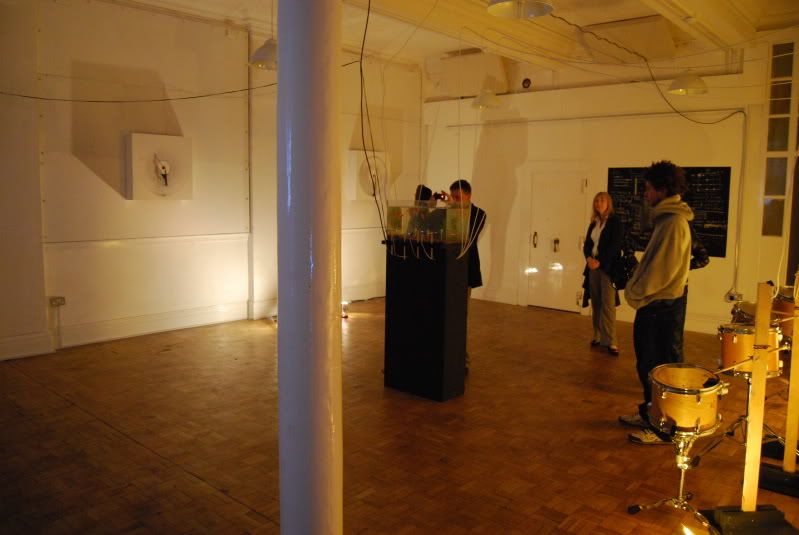
This exhibition at MAP (65 mabgate if you never went) was one of those random event ones. Two students from LCAD had organised this rather well its was only open for a few days and only half of those, I managed to catch it on its closing day.
The setup was centred with a fish tank on plynth. Inside this about ten orange fish swam about ocasionaly obstructing five beams of light that crossed the tank. Each time this happened an action was created in the room. A projector searched google images and chose at random pictures to display on a circular disc at the end of the room, pens attatched to a rod that span when triggered caused dodgey circles to be drawn on canvas, and against the other wall a line of drums played theirselves based on the movements of the aquatic vertabre.

Of course this bionic display was not serene, or upsetting. It just was. I mean i think its absaloutly fantastic that students should put on something so technologicaly ambitious but it didnt touch me. Ive seen or heard of enough exhibition machines based on chance and random events to not wince at another. But this doesnt subtract from it its not something id do (for lack of want) just, i like art when it tickles my insides and this just created aural discourse.
But this makes me think, cos i keep talking about this art in the head, does any of my work transcend the physical and will it ever? I mean I desire to create things from the physical out, not to manifest internal dialogues, but I think alot.
The things I make I want to be beautiful first, I will sacrafice this if thats the point, but it rareley is. I see this work and hear it and thats all I do I dont think about I dont twist my thoughts through it, in it, around it. So is this the same of other people when they look at me and the things I make?
In all honesty I didnt take art because I had a thing to say I took it because I liked doing it and importantly I liked seeing other people like what I had done, so if it even matters to me is the only question really. Gosh
[/Rant]
lots of I in that
Entrance view

You have really asked the key question. How does the materiality of art contain within it all the narratives, ideas and meanings that make it worthwhile as a thing to do? Why does stuff like this, (words and language based communication) seem to carry all the important concepts pretty easily, and hand crafted objects seem to be problematic as to what they communicate. I believe it’s just because we have a culture that on the one hand in education is language driven and on the other hand is separatist. By separatist I mean that we tend to want to categorise things and single them out as discrete things. Art rather than science, vocational rather than academic, poetry rather than prose etc. When I was a child I used to hum when I made things. The hum was a clear bi-product of what my hands were doing. I was told to stop it. We have forgotten how to sing objects into being, we have forgotten that making is materialised thought, we need to remember the simultaneity of vision, the compaction of meaning within objects and how it is released during social interactions. Touch is the educator of vision. I met an Indian sculptor some time ago. He tried to teach me how he was taught. He was blindfolded by a master sculptor and taken by hand to feel key sculptures. Moments of formal transition were indicated by pressure changes and directional change in how the master guided his hands. As these occurred the master recited poems from the Ramayana. The long and convoluted tale revolves around the struggle between two antagonistic forces, the principal action focusing on the trials and tribulations of Prince Rama, the abduction of his wife Sita, and the eventual defeat of Langka by Hanuman and his army of monkey warriors. Antagonism is formally resolved in sculpture in different ways. Different materials give differing weights to this. Stone contains the forever moment of Langka’s defeat, but in its very ability to take shape reflects that Langka is in reality just another face of God. As the hand travels the words sound, touch engages material thinking, narratives arrive out of the moments of formal change.
ReplyDeleteJust a bit of info: Have a look at Ricky Swallow's work. He combines high levels of carving skill with some interesting concepts.
ReplyDelete